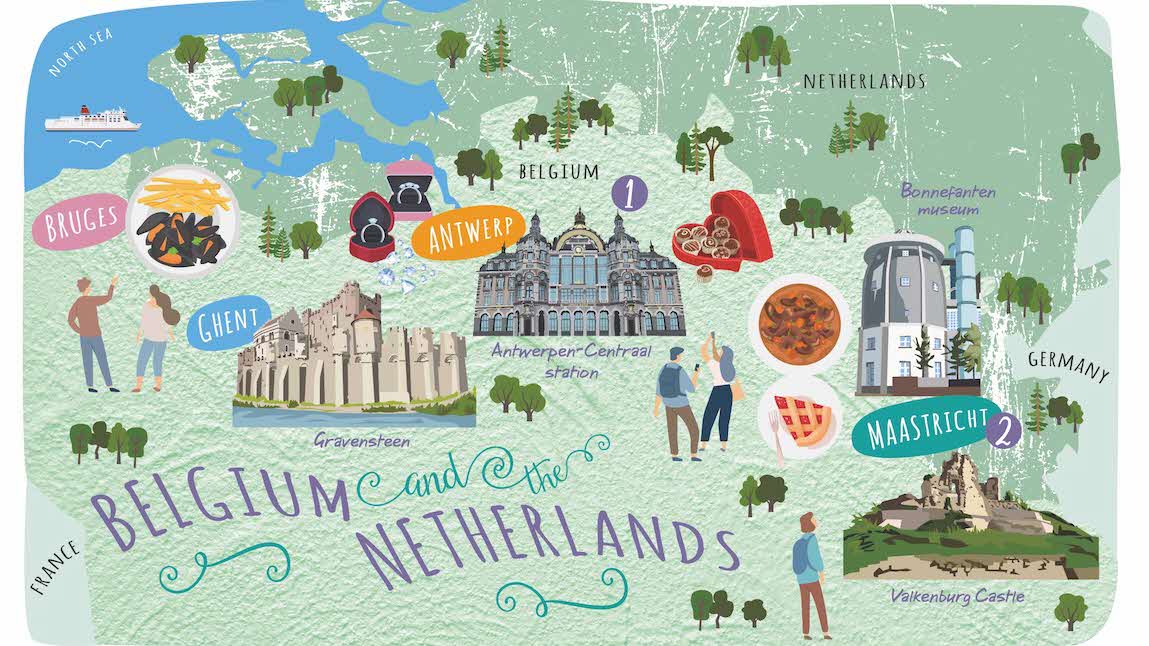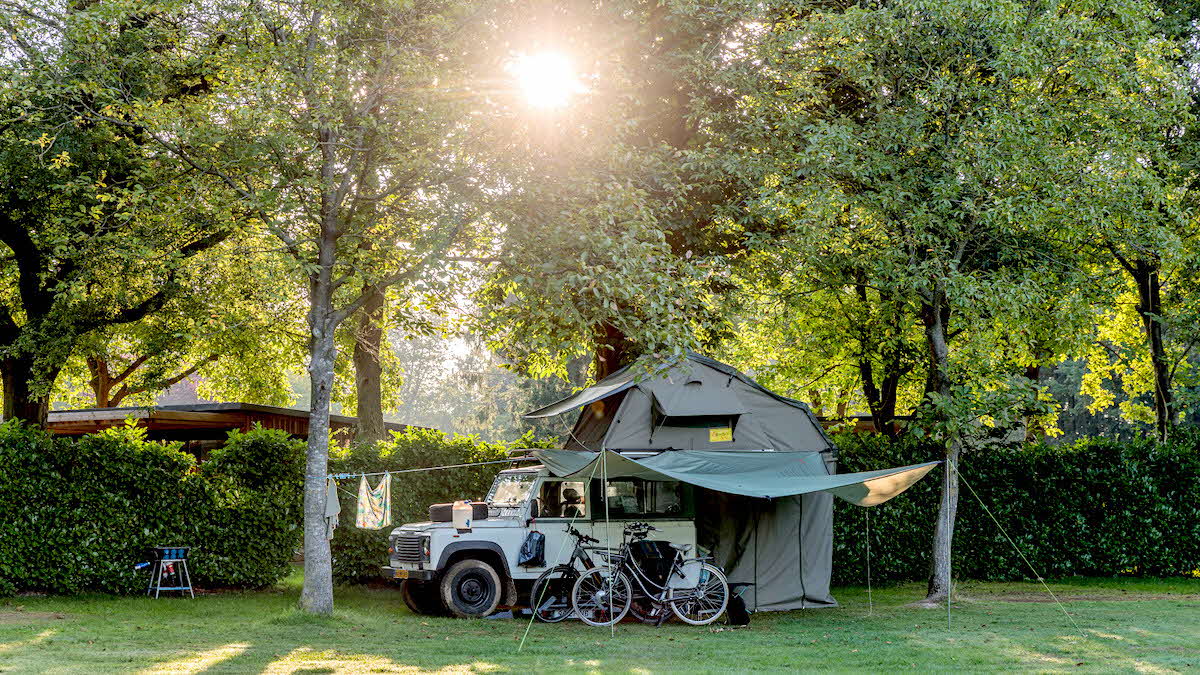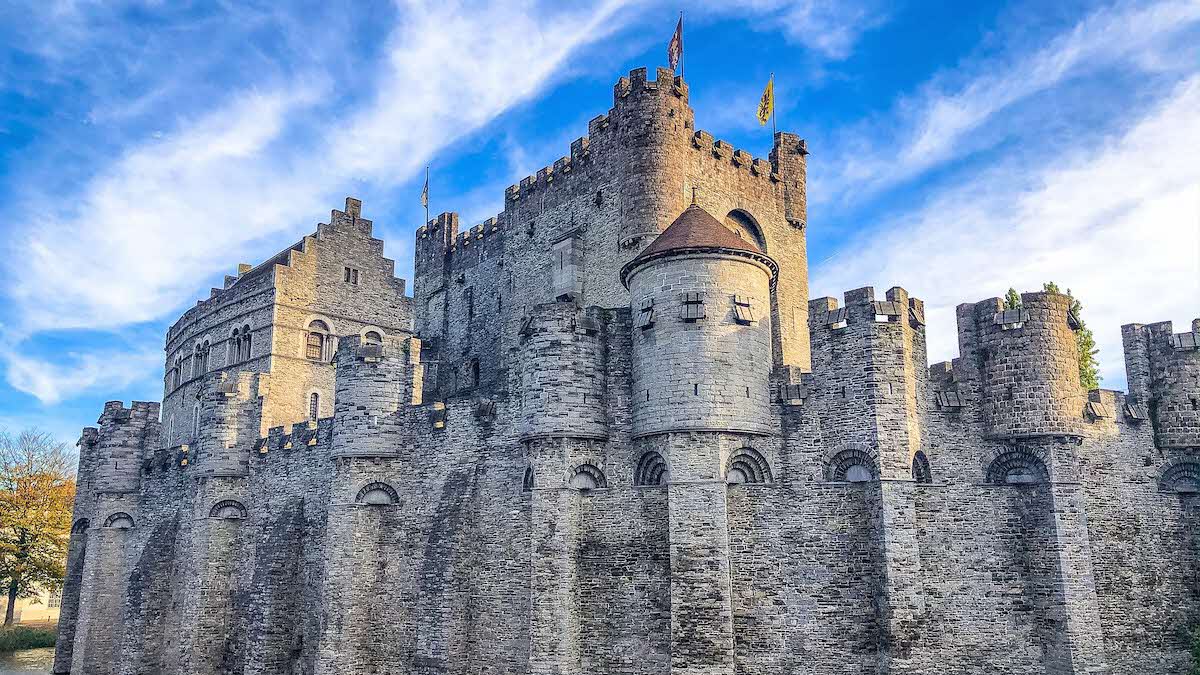Requirements for Driving in Europe
Check that you've got the correct documents and insurance to drive in Europe.
Find out moreHeidi Fuller-Love packs the ’van and relives childhood memories in Belgium and the Netherlands
 Illustration: Louise Turpin
Illustration: Louise TurpinEvery summer during my childhood, we would sail to the Belgian port of Zeebrugge in a wooden boat built by my father. From there we would drive along near-empty roads to our family home in the Netherlands (my mother was Dutch), close to the German border. Along the way, we’d always stop in Antwerp, where we’d buy ‘kroketten’ (deep-fried chicken in breadcrumbs) from vending machines.
Decades later, rolling off the ferry – at Dunkirk on this occasion – at the start of our five-day trip through Belgium and the Netherlands, I felt a twinge of anticipation about returning to an area I’d visited so many times in the past.
We headed directly for Bruges, just an hour or so’s drive over the French border. Known as the ‘Venice of the North’ because of its many canals, it is the capital of West Flanders and has been home to lace-makers since medieval times. The city is also famous for crafting some of the world’s best chocolates, so we stopped off to buy some and to stretch our legs.
After visiting the Sint-Anna Quarter, which is packed with chocolate shops, we wandered through cobbled streets framed by stately medieval buildings and fringed by swan-dotted canals to the Market Square (Grote Markt). There we found buildings as colourful as the pink and yellow marshmallow spekkies my mother used to put in our stockings at Christmas.
A short walk from here took us to the Steenstraat Quarter. Although this area is best known for its stylish shops, it’s also the home of Poules Moules, a gloriously cosy restaurant serving up Belgium’s famous dish of moules frites: hand-cut chips served with tender mussels in a lightly spiced beer sauce.
Tearing ourselves away from this lovely city, we followed an arrow-straight road framed by low brick houses, straggly hedges and ploughed fields to Lilse Bergen, a peaceful site roughly halfway between Eindhoven and Antwerp. The site is surrounded by dense pine forests and centres on a delightful little lake.
The following morning we feasted on the local sweet, curd-stuffed puff pastry Geraardsbergse mattentart with our coffee, before leaving the ’van at the campsite and making the 90-minute rail trip from Gierle to Antwerp, Belgium’s second city.
 Camping Valkenburg-Maastricht
Camping Valkenburg-MaastrichtDiamond capital of the world and the second-largest port in Europe, Antwerp is a fascinating blend of historic architecture, cool fashion and modern art. Arriving by train gave us the opportunity to admire Antwerpen-Centraal, the city’s Art Nouveau station, with its massive central cupola and ornate gilded interiors.
The city’s square-mile Diamond District (Antwerp has an association with the brightly polished gemstones since the mid-15th Century) is just a short walk from the station. Sadly, the DIVA diamond, jewellery and silver museum was closed for refurbishment, but we wandered through the streets admiring the dazzling store windows packed with precious items.
This lively city buzzes with chic shops, especially in area near the Momu fashion museum. We spent a fascinating hour there and then made a quick pitstop for a basket of Belgian chips and a glass of the locally brewed De Koninck beer at a local fritkoten (chip shop). We ended our day at the Rubenshuis, home of the artist, Rubens, which has been converted into a wonderful little museum devoted to the great man’s life and art.
Situated about 60 miles from Lilse Bergen, at the confluence of the Leie and Scheldt rivers, Ghent is another lovely medieval city built around its waterways. On a friend’s advice we stopped off at Vandenbouhede, a shop that sells every imaginable flavour of chocolate, before heading out on one of the city’s excellent free walking tours to see the sights, including the imposing medieval castle of Gravensteen; Graffiti Street, where it’s legal to spray and tag; and the 11th-century Korenlei quay in the atmospheric old town.
The following day we crossed the border into the southern Netherlands and headed for Camping Valkenburg-Maastricht, a delightful forest-shaded site with several pools and good-size pitches. Perhaps best of all, it is within easy reach of Maastricht. A tourist magnet in its own right, though, the town of Valkenburg is a short drive from the campsite. Sitting on the pretty Geul River, Valkenburg is home to the country’s only hilltop castle, and is also famed for its impressive caves in which the Romans mined marlstone.
We took the little train that trundles through labyrinthine passages lined with secret inscriptions and wall murals. Glad to be back above ground, a chairlift transported us to the top of the hill where we soaked up spectacular views over the town and surrounding Limburg region.
We finished the day by fortifying ourselves with big slices of the delicious local fruit pie ‘vlaai’ from Valkenburg’s bakery.
 Ghent Castle © Belgium Tourist Board
Ghent Castle © Belgium Tourist BoardOn the last day of our trip we headed for Maastricht. First stop was the Grand Café de Perroen overlooking Maastricht’s main square, where we had a breakfast of fluffy poffertjes (buckwheat pancakes).
With three Michelin-starred restaurants and countless eetcafés (gourmet pubs), it’s hardly surprising that Maastricht is known as the Netherlands’ culinary capital. We’d come to sample the food, of course, but before tucking in once again we explored the old industrial Céramique district, where we found trendy boutiques housed in medieval buildings.
Later, we stopped off to admire the Old Masters, medieval sculpture and contemporary art at the bizarrely rocket-shaped Bonnefanten museum. We ended our day spotting kingfishers and ragondin (semi-aquatic rodents) on a two-hour cruise along the Maas – or Meuse, as the French call it.
Our five-day break ended with a trip along memory lane, with a long lazy dinner at Den Ouden Vogelstruys, Maastricht’s oldest café. The chunky bloedworst (blood sausage) was spicy and tender, while the traditional beef casserole, zoervleis, with its sweet and sour sauce, was rich and comforting. Mother would surely have approved.